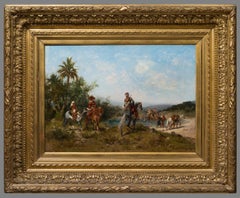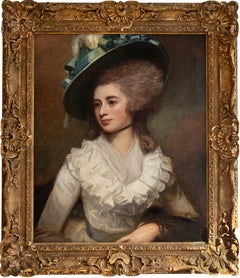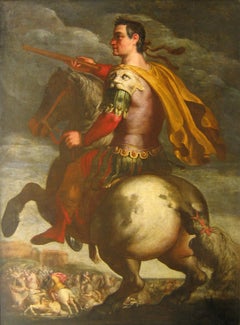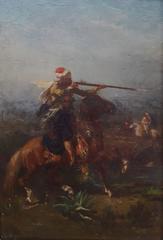Georges Washington Paintings
to
1
1
1
Overall Height
to
Overall Width
to
1
1
1
1
1
1
927
650
642
610
1
1
1
1
Artist: Georges Washington
Le Voyage - Halte au bord de l'Oued
By Georges Washington
Located in Paris, FR
Georges Washington
1827-1910 American
Le Voyage - Halte au bord de l'Oued
Oil on canvas
Signed lower right
Canvas: 16 7/8" high x 23 5/8" wide
Frame: 29...
Category
Late 19th Century Old Masters Georges Washington Paintings
Materials
Canvas, Oil
Related Items
Portrait of Lady Caroline Price
By George Romney
Located in Miami, FL
DESCRIPTION: Perhaps the best Romney in private hands. If Vogue Magazine existed in the late 18th century, this image of Lady Caroline Price would be ...
Category
1970s Old Masters Georges Washington Paintings
Materials
Canvas, Oil
Julius Caesar on Horseback
By Antonio Tempesta
Located in New York, NY
Provenance: Private Collection, South America
Antonio Tempesta began his career in Florence, working on the decoration of the Palazzo Vecchio under the direction of Giorgio Vasari. He was a pupil first of Santi di Tito...
Category
16th Century Old Masters Georges Washington Paintings
Materials
Oil, Canvas
18th century Portrait of a young girl, Miss Cator in a landscape, white dress
By John Russell
Located in Woodbury, CT
Portrait of a young British Girl, in her white dress with Pink Sash.
Choosing to acquire an 18th-century portrait of a young girl by English artist John Russell is an opportunity to...
Category
1780s Old Masters Georges Washington Paintings
Materials
Canvas, Oil
Free Shipping
H 21 in W 18 in
17th Century By Cerrini Virgin with the Child and angels Oil on Canvas
Located in Milano, Lombardia
Original canvas.
Beautiful ancient frame in carved, sculpted, gilded wood.
The painter illustrates the famous iconography of "The Virgin with the Child and Angels". We can have a lo...
Category
17th Century Old Masters Georges Washington Paintings
Materials
Canvas, Oil
H 33.86 in W 27.56 in D 1.97 in
A 17th c. Italian school, Capriccio with the Colosseum, circle of V. Codazzi
Located in PARIS, FR
A capriccio with the Colosseum in Roma
17th century Italian school
Circle of Viviano Codazzi (1604-1670)
Oil on canvas
Dimensions: h. 35.43 in, w. 51.18 in
Modern 17th century style ...
Category
17th Century Old Masters Georges Washington Paintings
Materials
Canvas, Oil
17th Century By Mondino Mystic Marriage of St Catherine of Alexandria Oil/Canvas
Located in Milano, Lombardia
"Cassetta" frame in sculpted, carved and gilded wood.
Antonio Mondino (information from c. 1610 to c. 1626) was an Italian artist who was active from 1617 to 1633. The painting, whi...
Category
17th Century Old Masters Georges Washington Paintings
Materials
Canvas, Oil
H 34.45 in W 39.38 in D 1.97 in
17th Century By Guidotti aka Cavalier Borghese Salomé and the Baptist Oil/canvas
Located in Milano, Lombardia
Original canvas.
Frame in sculpted, carved, gilded wood
Publications:
- M. Pulini, in La croce, la testa, il piatto. Storie di San Giovanni Battista, Cesena, Galleria Comunale d...
Category
Early 17th Century Old Masters Georges Washington Paintings
Materials
Canvas, Oil
H 35.44 in W 26.97 in D 1.97 in
17th Century by Simone Cantarini Adoration of The Magi Painting Oil on Canvas
Located in Milano, Lombardia
Simone Cantarini (Pesaro 1612 - Verona 1648)
Adoration of the Magi
Oil on paper applied to canvas, cm. 16,5 x 24 – with frame cm. 22 x 29
Antique sh...
Category
Early 17th Century Old Masters Georges Washington Paintings
Materials
Canvas, Cotton Canvas, Oil
17th Century by Juan Alfonso Abril Head of St Paul Painting Oil on Canvas
Located in Milano, Lombardia
Juan Alfonso Abril (active in the 17th century in Valladolid)
Head of Saint Paul
Oil on canvas, cm. 48,5 x 62 - with frame cm. 63 x 76,5
Shaped wooden f...
Category
Early 17th Century Old Masters Georges Washington Paintings
Materials
Canvas, Oil
H 19.1 in W 24.41 in D 1.97 in
Shipping in Stormy Waters, Attributed to Italian Artist Francesco Guardi
By Francesco Guardi
Located in Stockholm, SE
The splendour of the tragic sea
Francesco Guardi and maritime painting in Venetian art
No Venetian painter was a stranger to the sea. After all, Venice was not only one of the most prominent ports of the Mediterranean, but indeed a city literally submerged in the ocean from time to time. Curiously however, the famous Venetian school of painting showed little interest in maritime motifs, favouring scenes from the iconic architecture of the city rather than seascapes. That is why this painting is a particularly interesting window into not only the painter Francesco Guardi himself – but to the significance of the element of water in art history, in absence as well as in the centre of attention.
Whether it be calm, sunny days with stunning views of the palaces alongside the canals of Venice or – more rarely – stormy shipwrecking tragedies at sea, water as a unifying element is integral to the works of painter Francesco Guardi (1712–1793). During his lifetime, Venetian art saw many of its greatest triumphs with names like Tiepolo or Canaletto gaining international recognition and firmly establishing Venice as one of the most vibrant artistic communities of Europe. While the city itself already in the 18th century was something of an early tourist spot where aristocrats and high society visited on their grand tour or travels, the artists too contributed to the fame and their work spread the image of Venice as the city of romance and leisure to an international audience, many of whom could never visit in person.
Still today, the iconic image of Venice with its whimsical array of palaces, churches and other historic buildings is much influenced by these artists, many of whom have stood the test of time like very well and remain some of the most beloved in all of art history. It was not primarily subtility, intellectual meanings or moral ideals that the Venetian art tried to capture; instead it was the sheer vibrancy of life and the fast-paced city with crumbling palaces and festive people that made this atmosphere so special. Of course, Venice could count painters in most genres among its residents, from portraiture to religious motifs, history painting and much else. Still, it is the Vedutas and views of the city that seems to have etched itself into our memory more than anything else, not least in the tradition of Canaletto who was perhaps the undisputed master of all Venetian painters.
Born into his profession, Francesco lived and breathed painting all his life. His father, the painter Domenico Guardi (1678–1716) died when Francesco was just a small child, yet both he and his brothers Niccolò and Gian Antonio continued in their fathers’ footsteps. The Guardi family belonged to the nobility and originated from the mountainous area of Trentino, not far from the Alps. The brothers worked together on more challenging commissions and supported each other in the manner typical of family workshops or networks of artists. Their sister Maria Cecilia married no other than the artist Giovanni Battista Tiepolo himself, linking the family to the most renowned Venetian name of the time. During almost a decade, Guardi worked in the studio of Michele Giovanni Marieschi, sometimes simply known as Michiel, a painted similar in both style and motif. Canaletto is, however, the artist Guardi is most often compared to since they shared a mutual fascination for depicting the architecture and cityscape of Venice.
During the course of his career, Guardi tried his hand in many different genres. He was as swift in painting landscapes, Vedutas of Venice, sacred motifs, interiors and architectural compositions as he was in a number of other motifs. His style is typical of the Venetian school but also distinct and personal once we look a little closer. There is an absolute certainty in the composition, the choice of which sometimes feels like that of a carefully calculated photograph – yet it is also very painterly, in the best sense of the word: fluid, bold, sensitive and full of character. The brushwork is rapid, intense, seemingly careless and extraordinarily minute at the same time; fresh and planned in a very enjoyable mixture. His interiors often capture the breath-taking spacious glamour of the palaces and all their exquisite decor. He usually constructed the motif through remarkably simple, almost spontaneous yet intuitively precise strokes and shapes. The result was a festive, high-spirited atmospheric quality, far away from the sterile and exact likeness that other painters fell victim to when trying to copy Canaletto.
The painting here has nothing of the city of Venice in it. On the contrary, we seem to be transported far away into the solitary ocean, with no architecture, nothing to hold on to – only the roaring sea and the dangerous cliffs upon which the ships are just moments away from being crushed upon. It is a maritime composition evoking both Flemish and Italian precursors, in the proud tradition of maritime painting that for centuries formed a crucial part of our visual culture.
This genre of painting is today curiously overlooked, compared to how esteemed and meaningful it was when our relationship to the sea was far more natural than it is today. When both people and goods travelled by water, and many nations and cities – Venice among them – depended entirely on sea fare, the existential connection to the ocean was much more natural and integrated into the imagination. The schools and traditions of maritime art are as manifold as there are countries connected to the sea, and all reflect the need to process the dangers and wonders of the ocean.
It could symbolize opportunity, the exciting prospects of a new countries and adventures, prospering trade, beautiful scenery as well as war and tragedy, loss of life, danger and doom. To say that water is ambivalent in nature is an understatement, and these many layers were something that artists explored in the most wondrous ways. Perhaps it takes a bit more time for the modern eye to identify the different nuances and qualities of historic maritime paintings, they may on first impression seem hard to differentiate from each other. But when allowing these motifs to unfold and tell stories of the sea in both fiction and reality – or somewhere in between – we are awarded with an understanding of how the oceans truly built our world.
In Guardi’s interpretation, we see an almost theatrically arranged shipwrecking scene. No less than five ships are depicted right in the moment of utter disaster. Caught in a violent storm, the waves have driven them to a shore of sharp cliffs and if not swallowed by the waves, crushing against the cliffs seems to be the only outcome. The large wooden ships are impressively decorated with elaborate sculpture, and in fact relics already during Guardi’s lifetime. They are in fact typical of Dutch and Flemish 17th century ships, giving us a clue to where he got the inspiration from. Guardi must have seen examples of Flemish maritime art, that made him curious about these particular motifs. One is reminded of Flemish painters like Willem van de Velde and Ludolf Backhuysen, and this very painting has indeed been mistakenly attributed to Matthieu van Plattenberg...
Category
18th Century Old Masters Georges Washington Paintings
Materials
Canvas, Oil
Free Shipping
H 25.79 in W 29.14 in
Figure Ice Skating In Hyde Park, 18th Century Philip Jakob II DE LOUTHERBOURG
Located in Blackwater, GB
Figure Ice Skating In Hyde Park, 18th Century
Philip Jakob II DE LOUTHERBOURG (1740-1812)
Fine huge 18th century Old Master morning frozen winter landscape of figures skating at Hyde Park, oil on canvas. Stunning large scale superb quality and condition winter scene with figures skating on the frozen water. Though unsigned the style and detail is unmistakably De Loutherbourg with a very similar composition currently held in the UK Government Art Collection (Whitehall & Downing Street...
Category
18th Century Old Masters Georges Washington Paintings
Materials
Canvas, Oil
Testa di Santo Martire
Located in Balerna, TI
Sebastàn de Llanos Valdès (circa 1605-1677) testa di santo martire
Olio su tela, cm 50,5x72,5
Non vi sono dubbi in merito all’autografia del dipinto che spetta a Sebastian de Llanos y Valdes (1616-1677), come testimonia l’ iscrizione frammentaria posta nel margine inferiore destro della composizione. Il pittore spagnolo fu allievo di Herrera il Vecchio (1576-1656), poliedrico artista suo conterraneo, abile oltre che nel dipingere anche nella lavorazione del bronzo e nel campo della medaglistica. Nella famosa bottega dell’ Herrera, cui viene attribuito il ruolo di fondatore della famosa Scuola di Siviglia, gravitarono anche il tredicenne Velasquez, che vi rimase per un intero ano, e Ignacio de Riarte. Nel nostro dipinto raffigurante la testa...
Category
17th Century Old Masters Georges Washington Paintings
Materials
Canvas, Oil
Previously Available Items
Cavaliers Algériens au Combat
By Georges Washington
Located in Saint Augustine, FL
An original signed oil on board by French artist Georges Washington (1827-1901) titled "Cavaliers Algériens au Combat", c. 1879. Hand signed by Washington lower left "G. Washington". A very desirable painting by the famous Orientalists artist, scarce. Framed with linen liner. Framed size: 14.5" x 11.75". Board size: 9.125" x 6.25". Painting is dark with age, only needs surface cleaning. In excellent condition, no chips or paint loss.
Georges Washington was born in Marseille in September 1827, the artist was born out of wedlock and though he later stated on his marriage license of 1859 that his parents’ names were unknown, his mother is elsewhere recorded as Marie Besse. She however did not officially acknowledge him until 1868, by which time the forty one year old painter had established considerable artistic repute and had adopted the pseudonym Georges Washington, after America’s first President. Like most aspiring artists, the young Georges Washington moved to Paris, where he trained at the Ecole des Beaux Arts under François-Edouard Picot (1786-1868). Best known for his animated historical and battle scenes, Picot was to be the first major influence upon Washington’s future artistic career, instilling upon him a strong grounding in fine draughtsmanship and sound composition, which Washington combined with his own innate understanding for dramatic action. The artist’s exotic style was also indebted to his study and appreciation of the Romantic painters, especially Eugène Delacroix (1798-1863), whose Orientalists views were described with similarly brilliant and fluid oils. At the same time Washington’s art conveys a similar feeling to the work of Eugène Fromentin (1820-76) who often painted naturalistic Middle Eastern scenes...
Category
1870s Victorian Georges Washington Paintings
Materials
Oil, Board
Georges Washington paintings for sale on 1stDibs.
Find a wide variety of authentic Georges Washington paintings available for sale on 1stDibs. You can also browse by medium to find art by Georges Washington in canvas, fabric, oil paint and more. Much of the original work by this artist or collective was created during the 19th century and is mostly associated with the Old Masters style. Not every interior allows for large Georges Washington paintings, so small editions measuring 36 inches across are available. Customers who are interested in this artist might also find the work of Paul Emile Léon Perboyre, Charles Towne, and Sir Godfrey Kneller. Georges Washington paintings prices can differ depending upon medium, time period and other attributes. On 1stDibs, the price for these items starts at $50,110 and tops out at $50,110, while the average work can sell for $50,110.
Artists Similar to Georges Washington
Questions About Georges Washington Paintings
- 1stDibs ExpertApril 5, 2022How accurate various paintings of George Washington are varies. Generally, experts believe Charles Willson Peale's George Washington at the Battle of Princeton to be the most accurate portrayal of the first U.S. president. On 1stDibs, shop a wide variety of portrait paintings.
- 1stDibs ExpertApril 5, 2022Jean-Antoine Houdon's sculpture of George Washington is made of marble. It is currently on display in the rotunda area of the Virginia State Capitol in Richmond. You'll find a variety of Jean-Antoine Houdon art from some of the world’s top sellers on 1stDibs.



